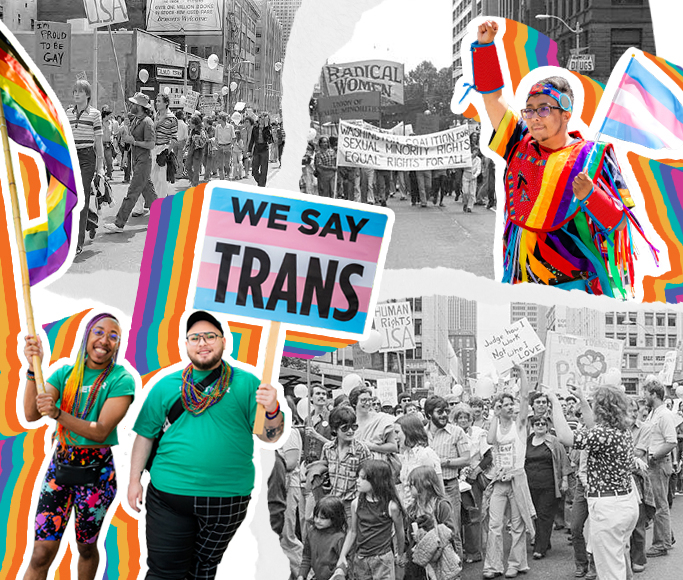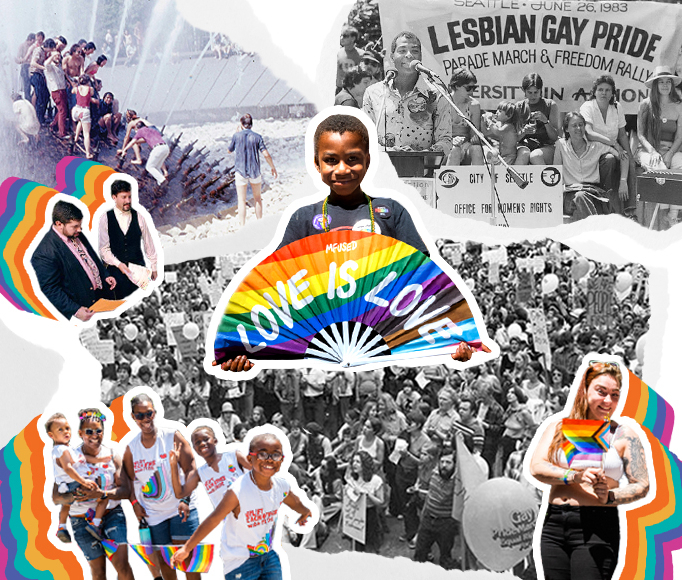More recent LGBTQIA+ history is rooted in 1969’s Stonewall uprising which sparked a movement, but what’s known about Seattle’s queer history dates back to the late 1800s when downtown Seattle’s Pioneer Square neighborhood – known also as “TheTenderloin,” “Skid Row,” and “Fairyville” – was more welcoming to the burgeoning gay community than the surrounding area, and it saw establishments catering to them flourish.
Here is a historical timeline of some important LGBTQIA+ milestones in Seattle, as the march for equal rights continues.
NOTE: In several instances, the historical timeline includes verbiage from source material reflecting the era and which may imply bias, rather than the more appropriate verbiage which used to today.
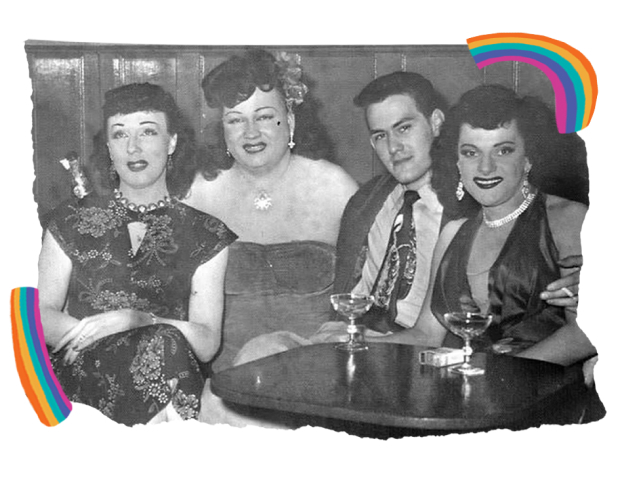
Jackie Starr, Hotcha Hinton, an unidentified man, and Tonya Del Raye sitting at a table at the Garden of Allah circa 1950s.
Photo courtesy of University of Washington Libraries, Special Collections, SOC7421.
Early 1900s:
“Fairyville” Flourishes in Pioneer Square
Gay bars flourish in Pioneer Square despite becoming victims to a police payoff system in which establishments owned by gay people and people of color are forced to pay money to police officers in exchange for “protection.” It isn’t until the 1970s that some of the corrupt officers are put on trial and convicted of receiving bribes and payoffs, and legislation is passed aimed at stopping the harassment of queer bars.
Harry Allen, a transgender man living in Seattle, is the subject of ongoing sensationalist local and national newspaper coverage from 1900 until his death in 1922.
1933
Seattle’s first after-hours club, pool hall, and card room – The Casino – opens in Pioneer Square and later becomes Madame Peabody’s Dancing Academy (or simply “The Dance”) which is known as one of the few places on the West Coast where same-sex dancing is allowed.
1934
Gay bars continue to flourish in Pioneer Square with the end of prohibition, including the opening of The Double Header known for its drag shows and “The Cracker Barrel” oompah band; the bar eventually becomes the oldest continually operating gay bar on the West Coast until its closing in 2015.
1946
Seattle’s first gay-owned bar, The Garden of Allah, opens in the basement of the Arlington Hotel located at Post Alley & Seneca featuring vaudeville, burlesque, and variety shows with female impersonators as its main attraction while fostering a sense of community among Seattle gays and lesbians throughout its 10-year run.
1950
Seattle’s first lesbian bar, The Hub, opens on Denny Way, and is soon joined by the Grand Union, Sappho’s Tavern, and the Silver Slipper.
1960s:
Stirrings of Resistance
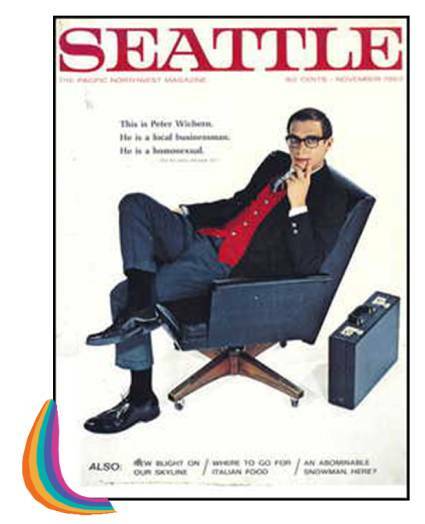
The Dorian Society laid the groundwork for a new image of the gay community including the 1967 Seattle Magazine cover story on local businessman Peter Wichern, as reported in the book “Gay Seattle” by Gary L. Atkins.Photo courtesy of Northwest Lesbian and Gay History Museum Project.
1967
Seattle’s first gay organization opens with the creation of the Dorian Society to spread awareness and advocacy. It leads to the creation in 1969 of The Seattle Counseling Services for Sexual Minorities, today known as Seattle Counseling Services.
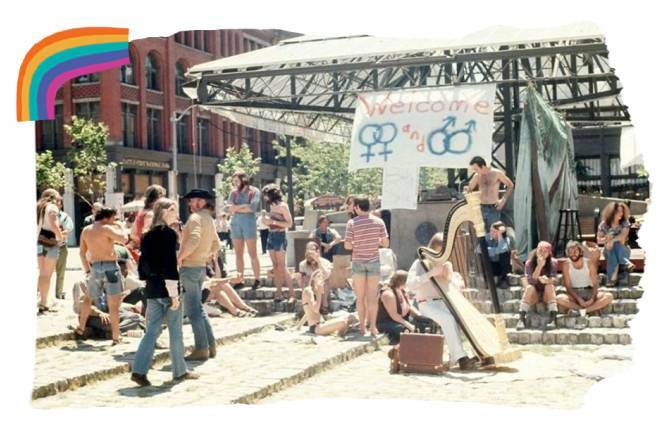
Gay Pride Week,” Seattle’s first Pride celebration included a picnic attended by about 200 people at Occidental Square Park in Pioneer Square on Saturday, June 29, 1974.
Photo Courtesy of David Neth.
1970s:
Igniting a Movement in Seattle
1970
The Seattle chapter of the Gay Liberation Front is formed, one year after the Stonewall rebellion.
1970
The Lesbian Mothers Defense Fund is founded in Seattle.
1970
The House of LaBeija is established in New York City and serves as an inspiration for Kiki Balls across the country, including those in the Pacific Northwest.
1970
Pioneer Square is established as both a National Historic District and a local preservation district by the city which drives up costs. As young LGBTQIA+ people begin to open bars, they find less expensive space on Capitol Hill, which evolves into the new gay neighborhood. Around this time young lesbian feminists begin to gather in the University District.
1971
The first Gay Community Center opens near Pioneer Square.
1971
The Lesbian Resource Center opens in the University District.
1971
Washington state repeals its sodomy law.
1973
City of Seattle ordinances ban discrimination in employment against sexual minorities.
1973
After losing her leg in a freak accident involving a cannon blast at a 1970 Bastille Day parade in Pioneer Square, Shelly Bauman uses part of her insurance windfall to open Seattle’s first unapologetically gay disco, aptly named Shelly’s Leg, quickly becoming one of Seattle’s most popular gay bars until its closing in 1977.
1974
Seattle’s first Gay Pride Week – organized by gay rights activist David Neth – includes a picnic and street dance (of approximately 200 people) in Pioneer Square’s Occidental Square Park (though not officially recognized by the city); as well as a “Gay-In” which features “zany dress, general frivolity, carousing, and a circle dance” around Seattle Center’s International Fountain; and a roller-skating sing-along at the top of the Volunteer Park Water Tower.
1974
Seattle Gay News (SGN) – the country’s third oldest LGBTQIA+ publication – is founded, providing an important voice reporting on issues within Seattle’s queer community.
1976
Gov. Dan Evans signs a bill to decriminalize anti-sodomy laws in Washington state.
1977
Seattle Mayor Wes Uhlman declares the “first official Gay Pride Week.” The Seattle Pride Parade – running from Occidental Square Park to Westlake Park by way of First Avenue – attracts more than 2,000 attendees. This parade route remains in place until the early 80s when it alternates years with Capitol Hill until it “permanently” moves to Broadway.
1977
The Ingersoll Gender Center opens.
1977
Black and White Men Together, now called Men of All Colors and Cultures Together, is formed in Seattle to fight racism within the gay community.
1978
City of Seattle ordinances ban discrimination in housing against sexual minorities.
1978
Two Seattle police officers file Initiative 13 and call the organization Save Our Moral Ethics, to repeal anti-discrimination ordinances. The Seattle Committee Against Thirteen/Women Against Thirteen use Occidental Square as its protest site against Initiative 13. Seattle voters reject the Initiative by 63 percent.
1979
Seattle’s PFLAG chapter is established.
1980s:
The Arrival of the AIDS Epidemic

Men embracing at AIDS vigil at Seattle Central Community College, May 29, 1988.
Photo courtesy of MOHAI, 2000.107.001.06.06, Photo by Melissa Stevenson.
1981
The Greater Seattle Business Association (GSBA) is established to foster patronage of gay businesses.
1982
The first case of AIDS is reported in Seattle. Over the next 10 years, more than 3,500 Seattle citizens will die from AIDS, with the vast majority being male and gay.
1983
Seattle becomes the second municipality nationwide to set aside funds for AIDS research and treatment.
1983
King County adds sexual orientation protections to its open housing ordinance.
1987
Cal Anderson is appointed state representative from Seattle’s 43rd District, becoming the first openly gay member of the Washington State Legislature.
1987
People of Color Against AIDS Network (POCAAN) is founded.
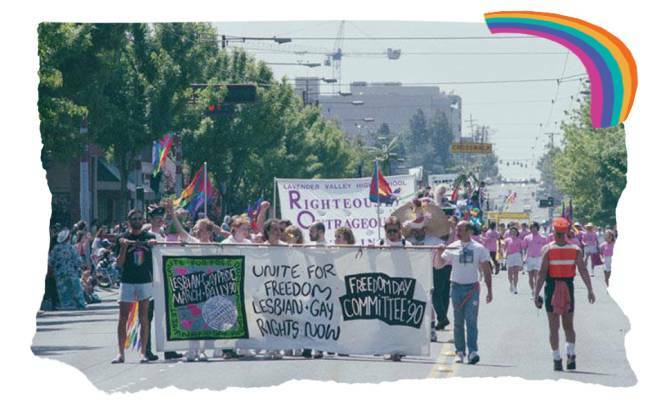
Freedom Day Committee ’90 members march in Seattle Pride Parade on Capitol Hill.
Photo courtesy of MOHAI, 2000.107.073.36.07.1, Photo by Kevin P. Casey.
1990s:
The March Continues
1991
Sherry Harris becomes the first self-identified lesbian to be elected to the Seattle City Council.
1991
Lambert House is established as a drop-in center for gay youth, the first of its kind in the U.S.
1991
Entre Hermanos is formed to promote the health and well-being of LGBTQIA+ Latinos.
1992
For the first time, the Seattle Pride festivities expand to officially include bisexual and transgender identities (LGBT).
1992
Bailey-Boushay House, operated by Virginia Mason Medical Center, opens – becoming the country’s first nursing care residence for people living with HIV/AIDS.
1997
Activists gather outside Seattle Central Community College for a rally “in support of those crossing, having crossed, or challenging gender and biological borders” in the first Trans Pride in the nation.
1997
Trikone Northwest is formed to support LGBTQIA+ South Asians in Seattle.
2000s:
Small Changes Make Way for Big Ones
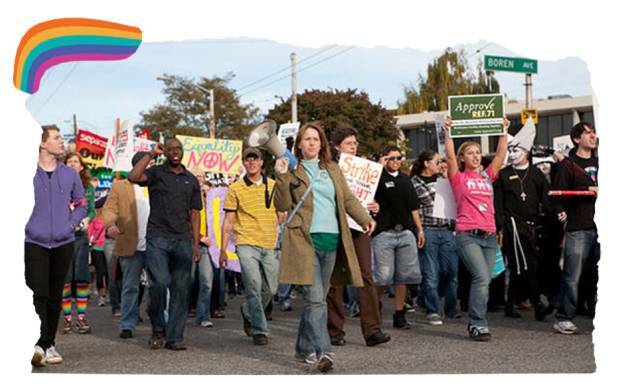
Supporters of Referendum 71, the “Everything But Marriage” ballot measure, march in one of many organized efforts in Seattle to mobilize voter turnout.
Photo courtesy of Jeff Romeo.
2000
Camp Ten Trees is founded as one of the first summer camps for children who are questioning or who identify as LGBTQIA+.
2003
Capitol Hill’s Lincoln Park is renamed Cal Anderson Park in honor of the state representative from Seattle’s 43rd District, who was the first openly gay member of the Washington State Legislature.
2006
Seattle Pride Parade moves from Capitol Hill back to downtown where it originated.
2006
Gov. Chris Gregoire signs into law Washington state’s first gay civil rights bill.
2006
Washington State Legislature passes first domestic partnership law focused on death and medical issues, including hospital visitation, funeral arrangements, inheritance, and insurance benefits for domestic partners.
2007
Domestic partnership for same-sex couples becomes legal in Washington state.
2008
Washington state expands rights of domestic partners with recognition of community property.
2009
Washington State Legislature passes – and citizens approve – Referendum 71, the “Everything But Marriage” law, extending all rights and obligations of married couples to domestic partners (to the extent allowed by federal law).
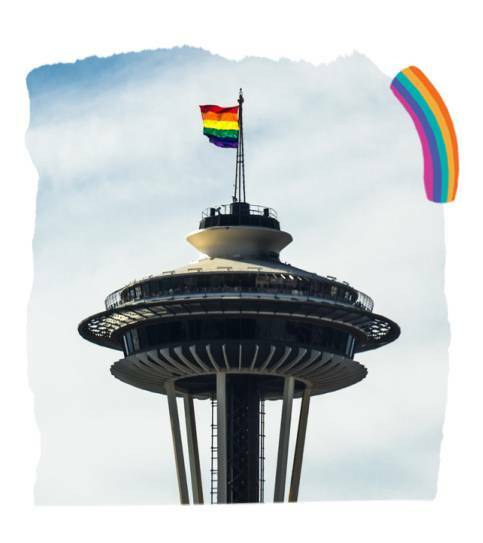
The rainbow Pride flag flies for the first time atop The Space Needle during Pride Month in 2010.
Photo courtesy of Nate Gowdy.
2010s:
Equality Comes Home
2010
The Space Needle flies the rainbow Pride flag for the first time.
2012
Washington State Legislature passes a bill to legalize same-sex marriage. Opponents quickly force a public vote after gathering signatures for a ballot referendum. The final vote of the public was 53.7% approving marriage equality.
2012
Pride Asia is formed in Seattle.
2013
Seattle elects Ed Murray as its first openly gay mayor.
2016
Seattle Children’s Gender Clinic opens as the region’s only multidisciplinary clinic serving transgender and gender diverse youth.
2016
The Washington State Black Trans Task Force, now known as the Lavender Rights Project, is formed to address the crisis of violence against Black trans women and femmes.
2017
Jenny Durkan is elected as Seattle’s first self-identified lesbian mayor and just the second woman elected to the position.
2020s:
Our Future is NOW
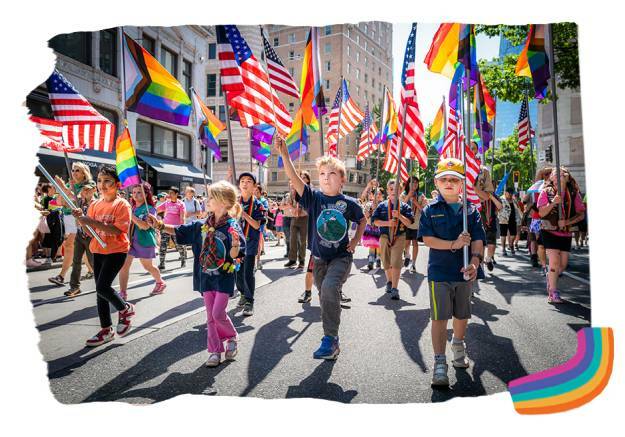
A youth contingent participates in the 2023 Seattle Pride Parade in downtown Seattle.
Photo courtesy of Nate Gowdy.
2020
Gov. Jay Inslee signs the Nikki Kuhnhausen Act into law, eliminating the legal strategy known as “LGBTQ+ panic defense.”
2020
Seattle-area organizers – from Trans Women of Color Solidarity Network, Queer the Land, and Alphabet Alliance of Color – establish Taking B(l)ack Pride to empower BIPOC transgender, queer, and gender-diverse communities to take charge of their collective joy, grief, healing, anger, celebration, pride, and expression of culture and community.
2020
Seattle Pride, PrideFest, and Gender Justice League (TransPride) collaborate on Seattle’s first virtual Pride celebration in response to the COVID-19 pandemic; a virtual Pride celebration is also held in 2021.
2022
Seattle Pride Parade returns after a two-year hiatus as a result of the pandemic; the parade attracts an estimated 300,000 members of the LGBTQIA+ community, friends, and allies – Washington state’s largest parade and one of the largest Pride parades nationally.
2024
Gov. Jay Inslee signs a bill mandating that public schools statewide teach students about the contributions and history of LGBTQIA+ people.
2024
Seattle celebrates the 50th anniversary of Seattle’s Pride celebrations providing the entire community an opportunity to celebrate the present, envision the future, and honor our past.
Seattle Pride’s 50th anniversary theme is NOW! in recognition of the original 1974 Seattle rallying cry calling for queer rights and visibility.
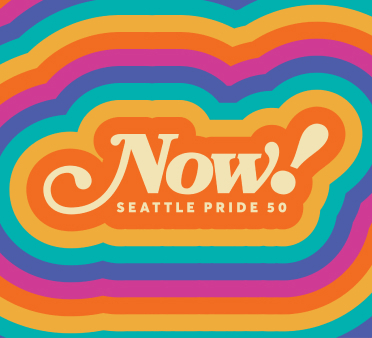
The March Continues
The timeline milestones above have been informed by a variety of trusted sources including ACLU, Cal Anderson Park Alliance, Camp Ten Trees, City of Seattle, CNN, HistoryLink, Gay Seattle: Pioneer Square and the Making of Queer Seattle, McKinley Irvin, National Institutes of Health, NBC News, NYC Pride, OutHistory.org, Out of the Past: 400 Years of Lesbian and Gay History in America, PBS, People, POCAAN, Seattle Children’s, State of Washington, The Evergrey, The History Channel, Today.com, United Way of King County, University of Puget Sound, University of Washington, USA Today, Virginia Mason Medical Center

